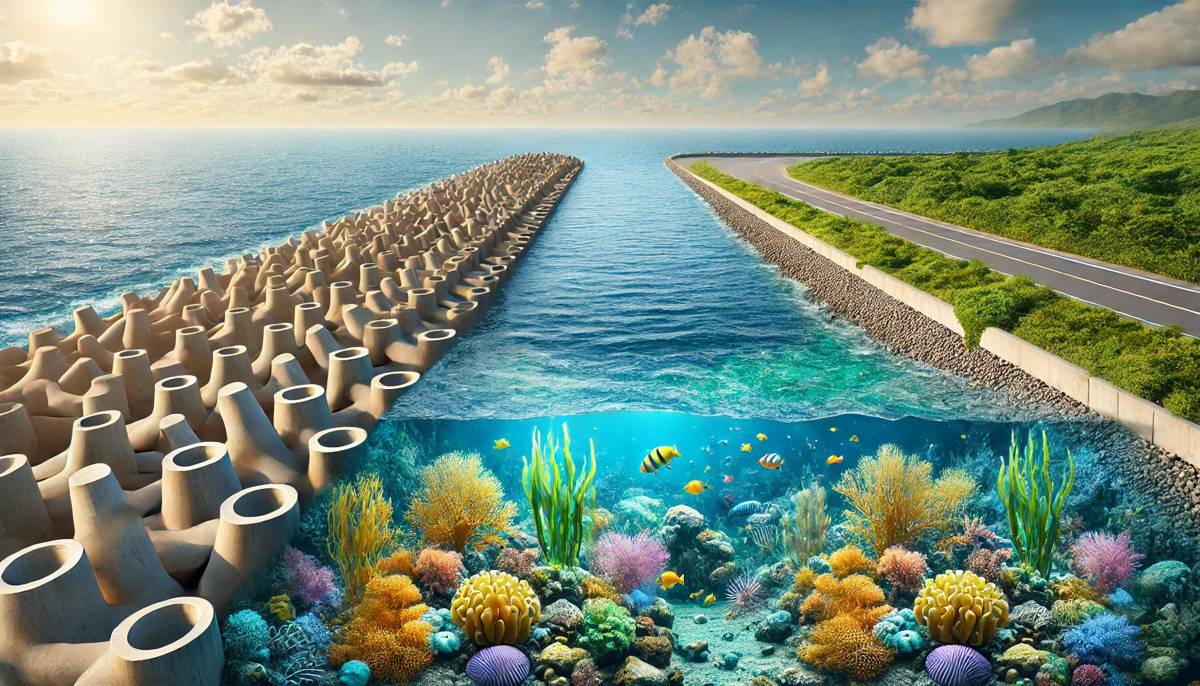Reinventing Coastline Protection with Biocompatible Cement
Coastlines are more than scenic views or tourist hotspots; they are dynamic ecosystems that underpin much of our planet’s ecological and economic stability.
The health of these coastal areas directly influences biodiversity, weather resilience, and local economies, from sustainable fisheries to tourism. Yet, as human development continues to press up against these vital borders, many natural coastlines face serious threats.
In response, engineered solutions like dikes, seawalls, and artificial reefs are often constructed to stave off erosion and protect coastal infrastructure. But, while these man-made structures do their job in shielding the coast, they often fall short in supporting the delicate ecosystems that thrive in natural habitats like coral reefs, mangroves, and wetlands.
Engineering with Nature in Mind
Artificial coastline structures are essential to protecting human development from rising seas, storms, and erosion. However, many such structures come with a hidden cost: they fail to support marine life in the same way natural coastlines do. The cement used in these structures, particularly, has long been known to disrupt marine ecosystems due to its high alkalinity, which inhibits biofilm formation—a critical element in marine food webs.
Recently, researchers from Southeast University and the University of Chinese Academy of Science have been exploring innovative ways to enhance the biocompatibility of cement used in coastline engineering. In their study published in Biointerphases, they experimented with treatments designed to reduce the harmful effects of traditional cement, aiming to create structures that are not only robust but also supportive of marine ecosystems.
The use of cement in artificial reefs, breakwaters, and seawalls has often been a double-edged sword. While it provides the necessary physical protection, its high alkalinity (pH levels of +12) proves toxic to marine life. “New substrate materials need to be developed to reduce the biological toxicity effects on marine organisms,” said Xiaolin Lu, one of the lead researchers on the project.
The Promise of Surface Treatments
The team explored two novel treatments that could mitigate the harmful effects of cement on marine life: polyacrylamide, a synthetic resin commonly used in water treatment, and chitosan, a natural sugar derived from the shells of crustaceans like shrimp. These treatments were applied both as a surface spray and mixed directly into the cement itself to create more marine-friendly structures.
When tested, the surface-treated samples yielded impressive results. Within just two days, biofilm—a slimy layer of microorganisms critical for supporting larger marine life—began forming on the treated cement. This growth continued over the following weeks, significantly outperforming untreated cement in its ability to support biofilm and coral survival.
The researchers found that while bulk treatments (where additives are mixed into the cement) also improved biocompatibility, they had a negative impact on the material’s mechanical strength. This makes surface treatments the more promising option, as they don’t compromise the cement’s structural integrity while still fostering a healthier marine environment.
Enhancing Marine Habitat with Bio-Compatible Cement
The study’s results mark a significant step forward in ecologically sensitive coastal engineering. Surface treatments offer an ideal balance—preserving the strength and durability of cement structures while fostering environments where marine organisms, like corals and algae, can thrive. The reduced alkalinity in surface-treated samples allows for the natural growth of biofilms, which in turn support a diverse range of marine life.
“Biofilms are foundational in marine ecosystems, providing food for grazers and promoting the settlement of larvae,” said Lu. By improving biofilm growth on artificial structures, the researchers hope to create coastline defences that don’t just protect against storms and erosion, but also actively contribute to the health of nearby ecosystems.
The team’s findings demonstrate that surface-treated cement can support coral and biofilm growth for up to 30 days, outperforming untreated cement in terms of both biocompatibility and durability. While bulk treatments helped reduce the biological toxicity of cement, they came at the cost of reduced mechanical strength—an issue that needs to be addressed before bulk-treated materials can be widely used.
Why This Matters for Coastline Management
With climate change accelerating the degradation of natural coastlines, the need for effective, sustainable coastal management has never been more urgent. Coastal ecosystems—especially coral reefs, wetlands, and mangroves—provide invaluable services by absorbing carbon dioxide, preventing erosion, and mitigating the impacts of storms. However, the rapid pace of urbanisation and the increasing severity of climate-related events are outstripping nature’s ability to recover.
Artificial structures, such as seawalls and breakwaters, offer essential protection but lack the self-regulating and restorative properties of natural coastlines. As this research shows, we can now take steps to make these structures more environmentally friendly, enabling them to play a role not only in protecting human settlements but also in preserving marine biodiversity.
Incorporating biocompatible materials into coastline defences could help reduce the ecological footprint of coastal development, making it a more sustainable practice. As governments, construction firms, and environmental agencies look for ways to mitigate the effects of climate change, innovations like these will likely play a crucial role in future coastal protection strategies.
What’s Next for Marine Cement?
Although the early results are promising, further research is needed before these biocompatible cements can be rolled out for large-scale projects. The next steps for the researchers involve testing the long-term wear and biocompatibility of treated cement in real-world marine environments. The team hopes that these surface treatments could eventually be used in the construction of artificial reefs, seawalls, and other coastal defences worldwide, providing both protection from the elements and a foundation for marine ecosystems to flourish.
The shift towards more sustainable coastal infrastructure highlights a growing recognition of the need to balance human development with environmental preservation. As Xiaolin Lu puts it, “These new treatments showed the necessary biocompatibility in a simulated marine eco-environment, which can be used to promote biofilm growth without interfering in extended habitation of model coral samples.”
Toward a More Sustainable Future
The push to develop biocompatible materials is not just about improving the longevity of coastal defences. It’s also about fostering ecosystems that can sustain themselves in the face of growing environmental pressures.
By taking a more integrated approach—combining engineering expertise with ecological insights—we can build structures that do more than simply stand up to storms. They can also become part of the solution to one of the most pressing challenges of our time: protecting our coastlines while preserving their natural beauty and biodiversity.




















